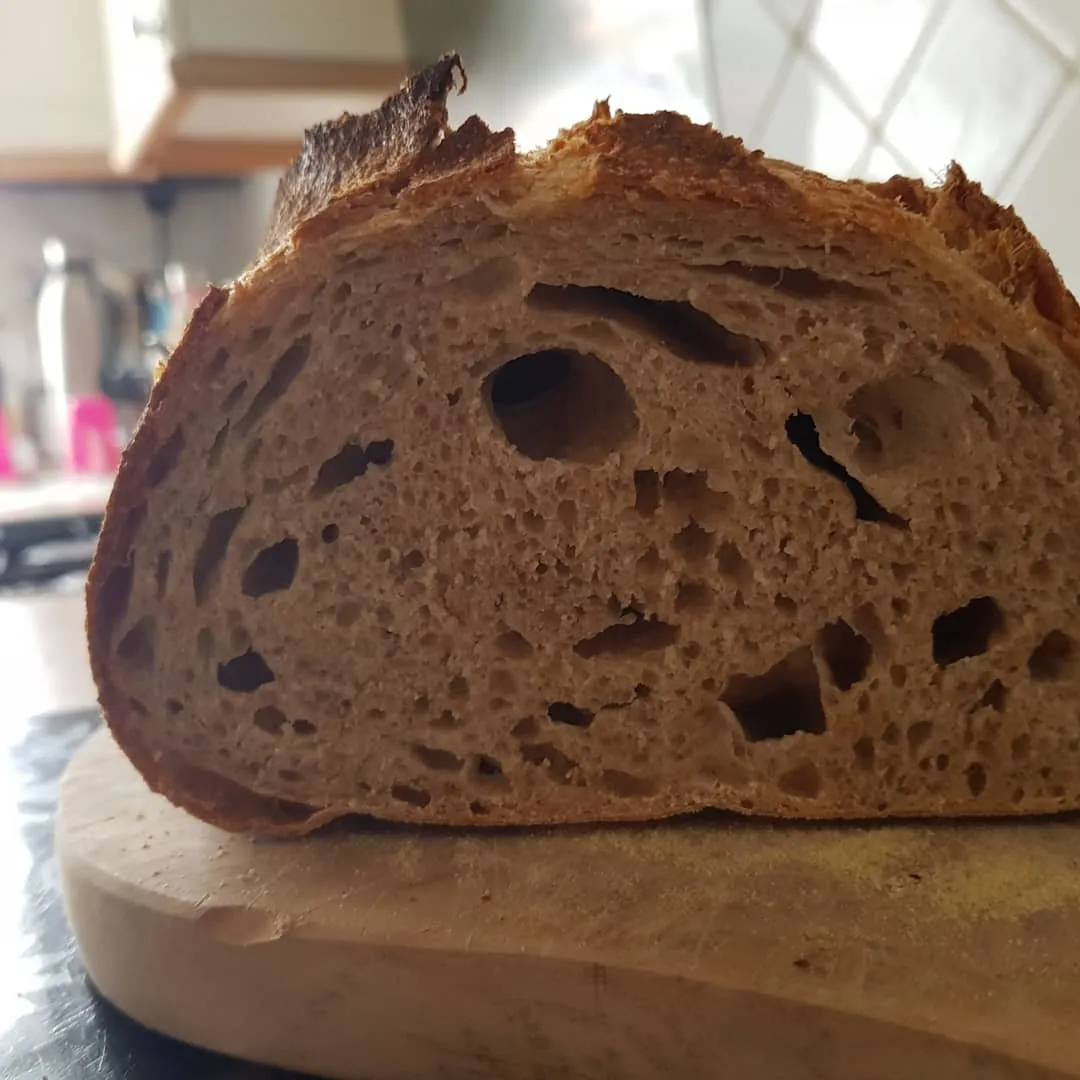Hello fellow bread people!
I bake a loaf about once every three days, and I'm trying to find the most effective and efficient way of keeping my starter in decent shape. I don't want to generate any discard if possible (my partner definitely wouldn't appreciate a tub of gooey gunk living in the fridge!).
I've decided to try this:
- bake a loaf using virtually all of my starter (100g for one loaf)
- immediately feed the dregs with 16 or 17g flour and the same amount of water, then leave out
- roughly 24 hours later, feed again with the same amounts as before
- another 24 hours later, repeat the feed
- once the starter looks ready, use virtually all of it, bar the dregs
- start the process again
My question is, does anyone know a reason why this might be a bad idea? I've made one loaf this way so far and it turned out great, but I know that problems often take time to materialise!
More info if it helps - I'm in England, and my room temperature is around 18 degrees Celsius at the moment (Google tells me this is 64.4 Fahrenheit - I'll take its word for it, I'm afraid I only understand C). My starter gets fed with wholemeal wheat or rye flour depending on what mood I'm in - I realise that this may not be the best idea!
Any thoughts would be much appreciated.
Ta!
After the bulk ferment keep some back, stored in the fridge, and use within three days as starter for the next loaf and so on.
Or keep a little bit of starter in the fridge. I'm talking about just a few grams. Feed the night before, use when ready and return the excess starter back to the fridge.
There are many ways. I can't see an issue with having a small tub of flour and water in the fridge.
Thanks Abe. I've thought about the old dough route and may well give it a go!
I was using the fridge method too (she can cope with a little jar of gunk, just not a huge tub of discard), but found that the starter seemed to get sluggish.
Cheers.
figure it is a probiotic cocktail for the septic system.
Good thinking Gerhard, a healthy sewer is a happy sewer.
Hi Abe
So I've now tried using the old dough technique (for yeasted bread rather than sourdough) and the results have been brilliant! This is definitely gonna be something I carry on with. Thanks!
Image

Image

It's what works best for your needs. That's a very nice loaf indeed! We do whatever is needed for the results we want. You have found a style that fits your criteria. Enjoy!
So simple, use whatever for a bake, multiply the number of days you want to go before feeding again, by the normal daily feed, throw it all in and just stir well a couple times a day till ya need it again. Enjoy!
Thanks Phaz. If I did this, would it keep the starter active for when I use it? Sounds like an easier way than weighing tiny amounts every day!
Cheers.
Tiny amounts every day - it does work, and it is a most inefficient method. I'm not a fan of inefficiency.
Will it keep it strong - it'll be as "strong" or as 'weak" as it is now as essentially there is no difference to the bugs.
Let's switch from food for the starter to food for thought. Standard procedure to fix a funky starter is a little starter, a lot of food, a little warmth and a little time. As that can fix a starter, why wouldn't it be the ideal way to maintain a starter? Enjoy!
Excellent, thanks again!
Chris, I keep a small amount of starter and feed it once per week. Like you I bake about twice per week and don’t have much discard. I generally know how much starter I’ll need for the week so will ensure that I have enough starter fed once per week to be able to make my two or three levains and still have 5 g or less left at the end of the week to feed and start again. If you have a healthy starter you can make a great levain any of those days during the week without having to refresh your starter.
So let’s say I’m baking twice and I’ll need 20 g of starter in total for those two bakes. I’ll make sure that I’ll have made at least 40 g of starter at the beginning of the week. So with my 5 g of leftover starter, I’ll just feed it 15 g water and 15 g flour. I’ll leave it in the proofing box to ferment and peak, then place it in the fridge. It is now ready for use for the whole week. Should I realize that I want to bake a third time, I’ll just feed it sooner than my usual once per week.
I never generate much more than 1 tsp of discard which I’ll literally discard. I haven’t made a discard recipe in many many months.
Benny
Hi Benny. That's great, thanks for the detailed info. It's good to know that a few bakes each week is possible without any major wastage!??
Benny - This is a great idea Benny! I have a couple of questions for you:
When you take the 5g of the starter out of the refrig, do you let the starter warm up, and then feed it (what temperature is the water).
You use your proofing box at what temperature, and how long in the proofing box.
Thanks
Vic
Vic, I don’t bother to let my starter warm up when I use it. I’ll warm up my filtered water to between 80-90ºF. So that warmed water and room temperature flour warm up the starter. Let’s say I’m starting with 5 g of starter and feeding it 20 g of water and 20 g of flour, so 1:4:4. I’ll set the proofing box to 80ºF and it’ll be at peak between 4-6 hours. Adjust the temperature down if you want it to take longer.
Hope that helps.
Benny
Benny - When the starter doubles. Sorry Benny! I need to know every detail. I know feeding the starter is very important for sourdough bread.
Thank again!
Peak is when the microbes are starting to run out of food. As the starter is rising there is a slight dome to the surface. When the microbes run out of food and gas production slows or stops the dome flattens and starts to fall. That point is peak.
I learned a lot tonight!
Thanks Benny